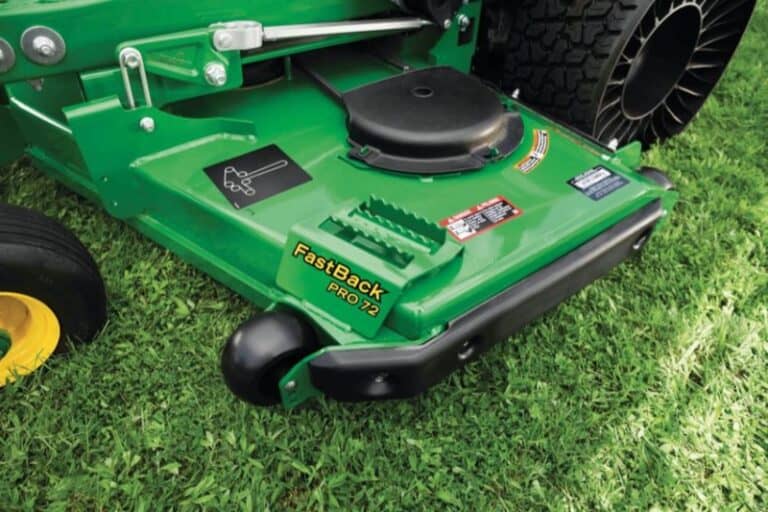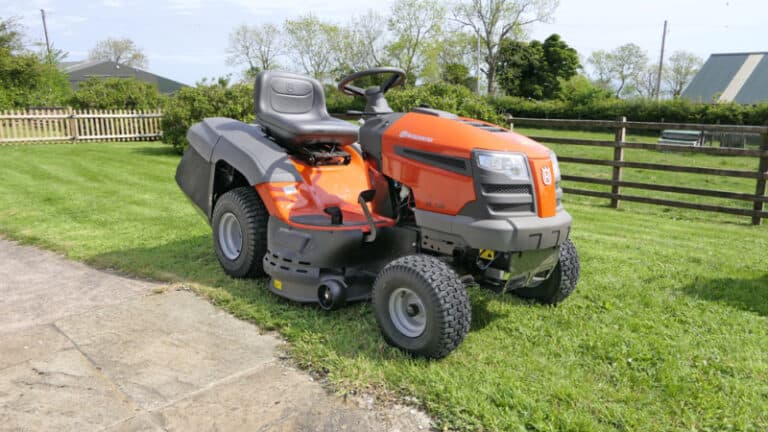How To Check the Hydraulic Fluid On a John Deere Tractor

The brand John Deere is one of the most respected and well-known in the tractor and heavy equipment industry. John Deere equipment is known for being durable and highly functional. Like most farm equipment and lawn equipment, there is specific maintenance that must be completed.
So, how do you check the hydraulic fluid in a John Deere tractor? The answer is quite simple. It involves a few steps similar to checking your oil in a car. Keep reading to learn more details.
How to Check Your Hydraulic Fluid
The steps for checking hydraulic fluid on a John Deere tractor are straightforward. Before you begin the process, familiarize yourself with the engine parts and where the hydraulic fluid dipstick is located on the tractor.
You’ll also want to ensure you have a rag or paper towel situated in a well-lit area to get an accurate reading.
First, you’ll want to ensure you’re in an open area where you can maneuver easily and see what you’re doing. Be sure the tractor’s engine is cold when you perform this task. It’s also important to note that the tractor needs to be on a level surface to get a good reading.
Next, you’ll want to park the tractor in an open area where you can maneuver easily and see what you’re doing. Be sure the tractor’s engine is cold when you perform this task.
It’s also important to note that the tractor needs to be on a level surface to get a good reading.
Only check your hydraulic fluid when your tractor is on a level surface. You’ll also need to ensure all the buckets and booms on the tractor are lowered.
These factors affect the reading, and you want to avoid miscalculations and provide plenty of hydraulic fluid to prevent damage to your tractor.
Checking The Hydraulic Fluid
The first thing you’ll need to do during the process is remove the cap from the hydraulic fluid reservoir. Although some models may vary, it’s typically found behind the tractor’s seat. If you don’t see it initially, you might be required to remove a cover or some housing first.
Once you’ve successfully removed the cap, the next step is to pull the dipstick out of its housing and look at the reading. There are markings on the dipstick to indicate the ideal hydraulic fluid level to help you determine if you need to add any fluid.
If you need to add fluid to your John Deere tractor, you’ll need to acquire a funnel to prevent spills onto the outside of the tractor.
Place the funnel inside the hole and pour the hydraulic fluid directly inside. Pour small amounts at a time and check to ensure you have enough and haven’t overfilled the reservoir.
If you need to remove any covers or plates, you’ll reinstall them after you have filled the hydraulic fluid reservoir adequately.
What Does Hydraulic Fluid Do?
Hydraulic fluid is an essential part of specific machinery. It serves as a medium for the transfer of energy and also provides lubrication for parts. It even acts as a sealant and keeps debris from entering the engine. It’s an essential component of any hydraulic equipment.
This fluid or oil is even more important than the oil in a gasoline-powered motor. An interesting point regarding hydraulic fluid is that it’s a non-compressible fluid that helps smoothly transfer the power generated by the engine to other parts to create the tractors’ functions.
How Often Do You Need to Change Hydraulic Fluids?
The frequency you need to change your hydraulic fluid can depend on the age of the tractor, the size, the model, and more. The average length of time, however, is approximately 100 hours for the first time. Each consecutive time after the first change should be around 200 hours.
The change frequency is shorter if you have models with filters. The tractors without filters can go much longer than those who have them. These John Deere tractors need their hydraulic fluid changed approximately every 600 hours.
If you have an older model or have had issues, you’ll need to change it more often. Just rule out a leak, as they can develop them over time. You want to avoid running your older John Deere tractor with the right amount of hydraulic fluid.
What Happens if You Don’t Change Your Hydraulic Fluid?
If you don’t change or replace the hydraulic fluid in your John Deere tractor, you’ll cause the parts to overheat, and that could potentially the engine will potentially ruin the engine. The engine’s moving parts need lubrication to move appropriately without generating heat. Additionally, if the hydraulic fluid gets too low, you risk letting debris get caught in the engine parts and run the risk of overheating.
Keeping your engine functioning correctly involves taking the time to maintain the hydraulic fluid at optimal levels. Try checking it each time you plan to use the machine to ensure you avoid running it at lower-than-optimal levels. This practice can also help ensure you identify a leak quickly and avoid leaving an opportunity for potential problems.
Types of Hydraulic Fluid
There are a few different types of hydraulic fluid. Familiarize yourself with the class your John Deere tractor requires. For example, there are petroleum-based varieties and synthetics. You don’t want to use the wrong type of hydraulic fluid in your tractor because they might not be interchangeable.
In terms of mineral-based hydraulic oil, it’s made from crude oil. This type is used widely throughout many industries and is the most common type for heavy equipment and tractors. Additionally, some are fire-retardant or resistant. Some others are also biodegradable and even compatible with food-related preparations. The best way to find out which type you need to use is to ask the dealer before you make your tractor purchase.
If you buy your tractor second-hand, consult the owner’s manual, or you can contact John Deere directly to inquire about the specific type of hydraulic fluid you need and how to check hydraulic fluid on John Deere tractor. It’s also a great way to learn how to regularly care for your tractor to help ensure it stays working for years.
What is Some Routine Care For a John Deere Tractor?
Checking the hydraulic fluid is just one of the basic care steps for owning and maintaining a John Deere tractor. You should perform basic care steps to help ensure the longevity of your tractor and prevent any damage.
Check Your Fluids Regularly
It’s essential to check the fluid levels in your tractor frequently. The three main fluids to check include hydraulic fluid, oil, and fuel levels. This practice allows you to keep your machine working efficiently and safely. It’s good practice to keep plenty of extra fluids on hand to add to your tractor as necessary.
Service Intervals
Your John Deere tractor should be serviced once per year or after 100 hours of running time. That means you’ll need to change the oil, the filter, and the spark plugs. This is also the time to check all components to ensure they are working correctly. This process is much like a tune-up on a car.
Important Tips to Remember
Remember, when this service is done, you should keep the tractor in a clean, dry place without dust and debris in the air. If there are dust particles in the air, they can make their way into the components of the tractor or inside the fluids, such as the hydraulic fluid or oil.
Servicing your John Deere tractor is easy when you use an authorized repair and service shop. They have the space, tools, and know-how to perform these steps without exposing the tractor to potential issues.
They can also identify any developing concerns related to parts breaking or something working improperly. Catching those issues early can help reduce the cost of repairing your tractor and ensure it runs efficiently.
Summary
Checking the hydraulic fluid on your John Deere tractor is very important. Follow the recommended steps to ensure your tractor is working as it should for its lifetime. You’ll need to remove the cap from the reservoir to check the levels.
The tractor needs to be cold and lower the booms before proceeding. Pull out the dipstick from the top of the reservoir and look at the levels in relation to the markings. If the level appears low, use a funnel to add the hydraulic fluid to the appropriate levels slowly.
Remember to check it regularly, service it, and completely change the fluids according to the recommended schedule.
You can also read:






